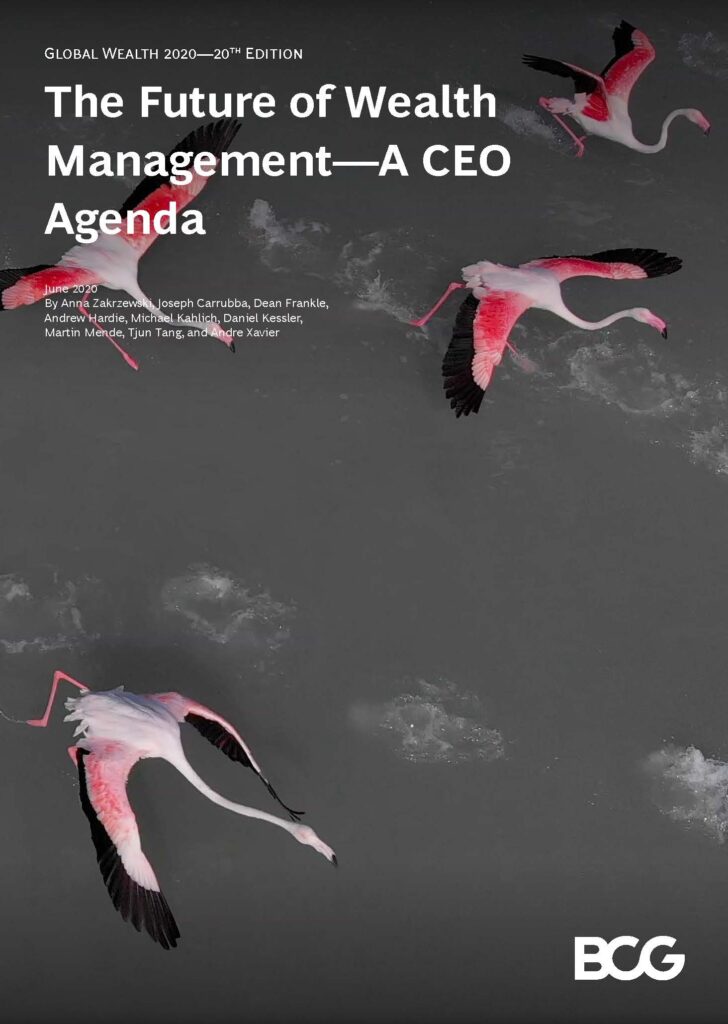What is this report?

In its 20th year, Boston Consulting Group is producing its Global Wealth Report looking at how wealth has grown and how it will expand in the future. The report looks at 97 markets and looks forward through 2040.
What are the key findings from the article?
- Wealth is resilient. Over the twenty years of the report, BCG has found wealth to continue to grow despite crises. There is more wealth in more hands now than at the beginning of the century, from $80.5 trillion in 1999 to $226.4 trillion at the end of 2019. The number of millionaires has gone from 8.9 million in 1999 to 24 million by 2019. This group holds over 50% of total financial wealth.
- High Net Worth ($1m – $100M) and ultra-High Net Worth ($100M+) segments have a higher share of their wealth tied up in equity than other segments. In contrast, the $250K and below segment only invested on average 9% of their assets in equities and investment funds so this segment’s wealth grew more slowly.
- Younger generations view wealth differently. “Generations X, Y, and Z will also be more educated and economically empowered than prior generations… For these younger generations, wealth won’t just be about money. It will also be about meaning, purpose, connection, and making a positive difference in the world.”
- The wealthy have higher expectations, but it’s still about relationship building. With the onset of chatbots, AI, robots and more, clients will have high expectations of wealth managers and their technological offerings. However, these tools will be needed in conjunction with deep relationships with wealth managers. Trust will remain key. But transparency and metrics will play a bigger role, especially with younger generations. And the wealth generation will be more than just a yield: “Many clients want their investments to have a bolder, purpose-driven narrative that creates engagement along with real-world outcomes.”
- Cross-border wealth will decline in the short term. In the twenty years, cross-border wealth increased from $3.1 trillion in 1999 to $9.6 trillion in 2019. However, BCG believes that it will decline by 5.4% in 2020 to 10.2%“driven by the performance of capital markets.” From 2021 to 2024, investors may “repatriate assets to make it easier to access liquidity” depending on how deep the economic downturn. In 1999, Western Europe was almost 50% of cross border wealth but now Asia is projected to reach 40% by 2024. Switzerland remains the number one destination but Hong Kong and Singapore are growing as havens for cross-border wealth.
What can I do as a result?
- Despite the economic volatility and uncertainty of the past few months, wealth still exists. There are people who will want to continue to give or start to give to organizations like your own. They want engagement, purpose, and impact–all things that fundraising can provide.
- Just as wealth managers will have to be more technologically savvy and provide more customized service to their clients, prospects may expect more from fundraisers and nonprofits. They will want greater transparency about their giving (use, metrics, etc.) and more of a personal touch from fundraisers. They may want to give their money to social impact funds. But fundraisers and nonprofits have to be attuned to how prospects want to be contacted, kept informed about projects, their giving and more.
- Since younger generation is becoming a greater force in philanthropy, nonprofits should consider a closer relationship with community foundations. Younger folks are starting to increase their giving from Donor Advised Funds (DAFs). Working closely with community foundations that hold DAFs may help your organization see more funding from these popular giving vehicles.
- Since HNW and ultra HNW have more wealth tied up in equity, your organization needs to get more savvy about non-cash gifts. Your organization should explore more complex forms of giving, including mixed gifts (like a part cash, part bequest, part trust gift).
- Nonprofits may want to take advantage of repatriated wealth from cross-border wealth in the near term. If nonprofits can provide real advantages to prospects, they may be able to garner greater rewards from these monies before they move across borders again. Offering complex gifts, as noted above, may be a great strategy.
Additional Resources
- Global Wealth 2020: The Future of Wealth Management | Boston Consulting Group 2020
- Cash is not King in Fundraising | Professor Russell James
- Not Asking for Millions? Why Should You Care About HNWIs? | Jennifer Filla blog 2018
- Regulatory Arbitrage: Billions of $hades of Green | Jennifer Filla 2019
- Capital Without Borders| Brooke Harrington | 2016
- Fidelity Charitable 2020 Giving Report: Inside Donor Advised Funds | Aspire Research Group 2020